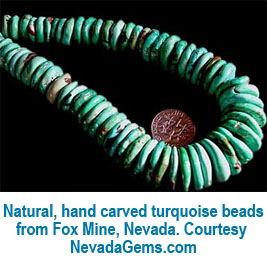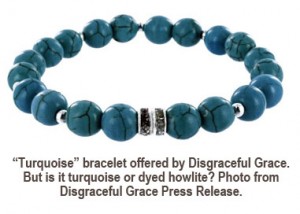 Turquoise is one of those gemstones whose popularity never seems to diminish. It’s been mined in various parts of the world for thousands of years and treasured by a number of ancient and modern cultures, including our own.
Turquoise is one of those gemstones whose popularity never seems to diminish. It’s been mined in various parts of the world for thousands of years and treasured by a number of ancient and modern cultures, including our own.
The problem is that many of the mines producing high quality turquoise have been depleted and much of the turquoise on the market today is reconstituted or a simulation. In addition, some dealers sell other material as turquoise.
This means that if you are buying turquoise, it’s vitally important you inform yourself about the market.
The following is an overview of the gemstone and various treatments. I don’t suggest it’s comprehensive, however, it should be a good starting point. In addition, I’ve added links to various sites which offer comprehensive information on the gemstone.
- Sources – The earliest sources of turquoise were Persia (Iran) and Egypt. The best of this turquoise was a robin egg blue and shows no matrix. Today, you will hear very high quality turquoise sometimes described as “Persian” turquoise. This refers to quality, not to place of origin. Most turquoise on the market today originates in the United States and China, although there are other producers. It is important to understand that the best mines have been played out and although some quality turquoise is produced, the vast majority of turquoise on the market today is lower quality.
- Matrix – Turquoise is one of the few gemstones found in a rock matrix. This manifests in the dark veins that run throughout the gemstone. Turquoise matrix can be black, yellow and brown. You will also hear the term “spider webbing” to describe the matrix. This refers to gemstones with thin lines of matrix running throughout it like a spider web.
- Properties – Turquoise is soft and porous. Because it’s soft, it is subject to fracturing and because it’s porous, it’s subject to discoloration. That is, it’s susceptible to staining, discoloration and fading.
- Treatments – Most turquoise is treated. The goal of treatment is to stabilize the gemstone so it won’t break or discolor. Treatments for turquoise are thousands of years old and include animal fats, oil and waxes. Today, treatments are considered advances on these ancient treatment methods. Current treatment methods include epoxy, resin or some other form of liquid plastic. In addition, some companies have developed propriety treatments including “pressurized” methods which force the hardening solutions deep into the rough.
- Reconstituted Turquoise – Most inexpensive turquoise has been reconstituted. Simply, the process involving powdering low quality turquoise and mixing it with some kind of binding agent. The mixture is poured into a mold, dried and cut into slabs. Reconstituted turquoise also is almost always dyed to enhance color.
- Misnomers – Misnomers are names given to stones that are misleading. One of the clues to recognizing is misnomer is a modifier in the name. African emerald for example is green fluorite. A common misnomer for turquoise is African Turquoise which is jasper.. Howlite Turquoise is a white mineral which has grey veins. It’s often dyed and called Howlite Turquoise or simply passed off as turquoise. (Study the matrix. If it’s grey and thin, the material you’re looking at could be howlite.) “Turquoise Magnesite” is dyed magnesite.
 Treatments are not in themselves “bad.” Turquoise often must be stabilized or it will fracture. The issue, as always, is disclosure. Reputable dealers will be willing to discuss treatments with their clients. It’s also worth noting that treatments have become so good in recent years that it’s sometimes difficult for gemologists or even turquoise experts to tell the difference between treated turquoise and natural turquoise. Here, however, are some certainties.
Treatments are not in themselves “bad.” Turquoise often must be stabilized or it will fracture. The issue, as always, is disclosure. Reputable dealers will be willing to discuss treatments with their clients. It’s also worth noting that treatments have become so good in recent years that it’s sometimes difficult for gemologists or even turquoise experts to tell the difference between treated turquoise and natural turquoise. Here, however, are some certainties.
- Most of the mines producing high quality turquoise have been played out.
- Most turquoise is treated in some way.
- If a dealer claims the turquoise is “natural,” question him closely and if you buy make sure this claim is reflected on the receipt.
- In the case of turquoise, it’s important to buy from a dealer you know and respect.
There are a couple of really outstanding websites providing solid turquoise information. Here are my favorites.
- https://www.traderoots.com – History of turquoise, information on treatments.
- https://www.turquoiseguide.com – A non-commercial site dedicated solely to providing information about turquoise.
- https://www.nevadagem.com – Devoted entirely to describing specific mines in Nevada. An excellent and compelling source of information.

